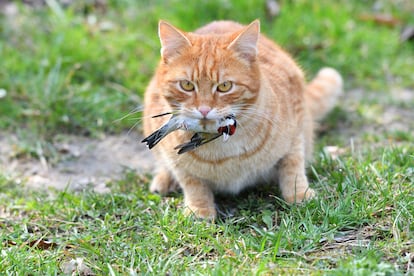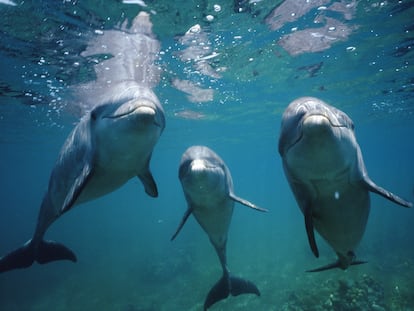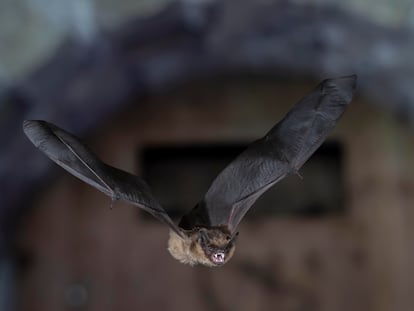Free-ranging cats are a threat to nearly 350 species of conservation concern in the world
A study analyzed the environmental impact of these felines, which hunt more than 2,000 different species of birds, reptiles, mammals, insects and amphibians

Cats have accompanied humans for more than 9,000 years, when they were first domesticated to help combat rodent and cockroach infestations. The house cat (Felis catus) is now one of our most beloved pets, but also one of the most abundant carnivores on Earth. Cats have not lost their hunting instinct and, as their population has grown, they have become an invasive species with a significant impact on biodiversity. The scientific community had warned of this threat earlier, but a team led by Christopher Lepczyk, a biologist at Auburn University in Alabama, has conducted the first analysis of animals hunted by domestic cats worldwide: cats are predators for more than 2,000 species including birds, reptiles, mammals, insects and amphibians. And at least 17% of these animals, 347 species, are of conservation concern, including some that are critically endangered. The findings, the authors say, are meant to improve our understanding of cats’ impact on ecological systems and help develop management solutions. The study was published on December 12 in the journal Nature Communications.
Lepczyk, who also works in wildlife conservation, says he was very interested in having a more complete view of the eating patterns of domestic cats — owned or unowned — with access to the outdoor environment. Together with his team and with the help of a librarian, he spent “a considerable amount of time” reviewing previously published scientific literature, even some that was not available electronically. After overcoming that challenge, the team members ensured that all species names were consistent and up-to-date. The result: cats are not picky eaters and are predators of “virtually any animal they can catch,” Lepczyk explains. In the database built by the researchers there are 2,084 species, of which 981 (47%) were birds, 463 (22%) were reptiles and 431 (21%) were mammals. There were also 119 species of insects (6%) and 57 types of amphibians (3%). Among those in danger are the near-threatened western quoll from Western Australia, the endangered green sea turtle and the now extinct Stephens Island Rockwren.
The large number of birds that cats consume did not surprise the researchers, considering the comparison of existing species worldwide (11,000 birds vs. 6,500 mammals). They also identified that the consumption of reptiles is similar to that of mammals (463 reptile and 431 mammal species, respectively). What did catch their eye was the “notably high” number of insects and invertebrates in cat diets.
Although the study is distributed globally, most of the results come from Australia and North America, while Africa and South America are underrepresented. Therefore, scientists highlight that the real number of species consumed by cats will continue to grow as more studies are carried out. Manuel Nogales, a researcher at Spain’s National Research Council (CSIC) who did not participate in the study, agrees with this statement: “The numbers are underreported, as the authors themselves say; the figure will probably reach 2,500 and will increase as studies continue to be published in the future.”
Spain, an example of bad legislation
Nogales, along with other researchers, had previously studied the impact on Spain’s Canary Islands of feral cats, that is, those that have reverted to the wild state and behave like any wild species without depending on human care for their survival. These cats are present on all the islands of the archipelago and occupy a wide variety of habitats, from the coast to high mountain areas, where they hunt all types of animals. Although Nogales emphasizes that this is a global problem, he notes that Spain has a lot of room for improvement and was critical of the fact that “scientific knowledge was not taken into account” in the recent animal rights and welfare law passed by the leftist coalition government headed by Pedro Sánchez of the Spanish Socialist Party (PSOE).
Nogales explains that this legislation does not distinguish between domestic cats and feral cats, which makes it difficult to take action to control their impact on numerous native species. He underscores the impact of the cats’ diet on the unique habitats of the Canary Islands, where “the damage is significant,” a statement backed up by years of scientific research. Domestic cats, he explains, also affect other animals living in urban and rural areas.
Globally, cats are linked to the extinction of 63 vertebrate species. In island ecosystems they have been involved in 14% of all extinctions of birds, mammals and reptiles and in the decline of 8% of species classified as critically endangered. Both Nogales and Lepczyk hope that this and future studies will contribute to addressing the ecological impact of cats, protecting both them and the species they consume.
Sign up for our weekly newsletter to get more English-language news coverage from EL PAÍS USA Edition
Tu suscripción se está usando en otro dispositivo
¿Quieres añadir otro usuario a tu suscripción?
Si continúas leyendo en este dispositivo, no se podrá leer en el otro.
FlechaTu suscripción se está usando en otro dispositivo y solo puedes acceder a EL PAÍS desde un dispositivo a la vez.
Si quieres compartir tu cuenta, cambia tu suscripción a la modalidad Premium, así podrás añadir otro usuario. Cada uno accederá con su propia cuenta de email, lo que os permitirá personalizar vuestra experiencia en EL PAÍS.
¿Tienes una suscripción de empresa? Accede aquí para contratar más cuentas.
En el caso de no saber quién está usando tu cuenta, te recomendamos cambiar tu contraseña aquí.
Si decides continuar compartiendo tu cuenta, este mensaje se mostrará en tu dispositivo y en el de la otra persona que está usando tu cuenta de forma indefinida, afectando a tu experiencia de lectura. Puedes consultar aquí los términos y condiciones de la suscripción digital.
More information
Últimas noticias
Most viewed
- Sinaloa Cartel war is taking its toll on Los Chapitos
- Oona Chaplin: ‘I told James Cameron that I was living in a treehouse and starting a permaculture project with a friend’
- Reinhard Genzel, Nobel laureate in physics: ‘One-minute videos will never give you the truth’
- Why the price of coffee has skyrocketed: from Brazilian plantations to specialty coffee houses
- Silver prices are going crazy: This is what’s fueling the rally











































